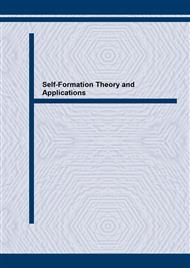p.195
p.201
p.207
p.215
p.221
p.225
p.229
p.235
p.239
The Polar Sulfonic Groups Influence on Structure of Self-Assembled Tetrapyrrolic Molecules
Abstract:
An understanding of both the interactions between the adsorbate molecules and the interactions between adsorbates and the surface is a prerequisite to eventually controlling the selfassembly process in supramolecular aggregation. Here we report the formation of supramolecular structures (J-aggregates) whose size and aggregation pattern are controlled by changing the number of polar sulfonic groups of meso-tetra (4-sulfonatophenyl) porphine. Using atomic force microscopy we show that substituted porphyrin molecules (5,10,15,20-tetrakis(4-sulfonatophenyl) porphine (TPPS4), 5,10,15-tris(4-sulfonatophenyl)-20-phenyl porphine (TPPS3), 5,15-bis(4-sulfonatophenyl)- 10,20-diphenyl porphyne (TPPS2op) - SO3 groups are opposite each other, and 5,20-bis(4- sulfonatophenyl)-10,15-diphenyl porphyne (TPPS2a) . SO3 groups are adjacent each other) form different spatial structures. Our findings suggest that placement of functional groups that are participating in direct noncovalent interactions will allow design and construction of different supramolecular structures adsorbed to surfaces.
Info:
Periodical:
Pages:
221-224
Citation:
Online since:
April 2004
Authors:
Price:
Сopyright:
© 2004 Trans Tech Publications Ltd. All Rights Reserved
Share:
Citation:


